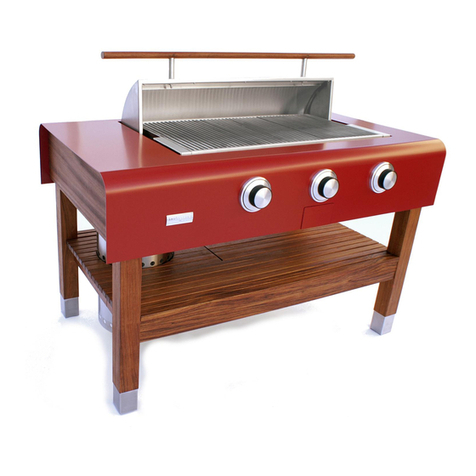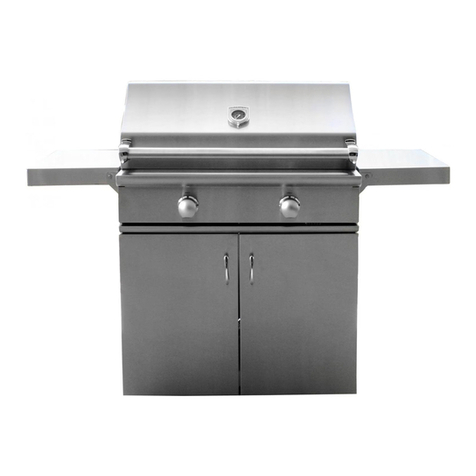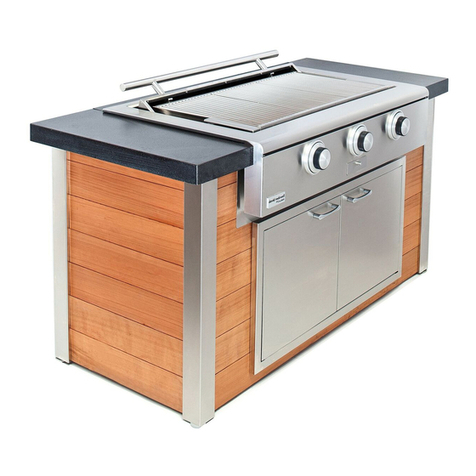
5
WARNING!
Spiders and insects can nest in the grill burners , causing gas not to ow through the burner. e gas will ow from
the front of the burner into the control panel. is is a very dangerous condition which can cause a re to occur
behind the valve panel, thereby damaging the grill components and making it unsafe to operate. If this occurs, call for
service immediately.
WARNING!
Keep the area surrounding the grill free from combustible materials, trash, or combustible uids and vapors such as
gasoline or charcoal lighter uid. Do not obstruct the ow of combustion and ventilation air.
WARNING!
Never use the grill in windy conditions. If located in a consistently windy area (oceanfront, mountaintop, etc.) a wind
break will be required. Always adhere to the specied clearances listed.
»Aer a period of storage or non-use (such as over the winter), the gas grill should be checked for gas leaks, deteriora-
tion, proper assembly, and burner obstructions before using.
»Never lean over an open grill. When lighting a burner, always pay close aention to what you are doing. Be certain you
are pushing the ignition buon when you aempt to light the grill.
»Aer lighting burners, make sure burners are operating normally.
»When using the grill, do not touch the grill burner, grate, or immediate surrounding area as these areas become ex-
tremely hot and could cause burns.
»When using the side burners always use at boomed pans which are large enough to cover the side burner. Adjust the
ame so that it heats only the boom of the pan to avoid ignition of clothing. Position handles inward away from open
edges of the unit to avoid burns associated with unintentional spill overs. Hold the handle of the pan to prevent move-
ment of it when turning or stirring food. For proper lighting and performance of the burners keep the ports clean. It is
necessary to clean periodically for optimum performance.
»Clean the grill with caution. Avoid steam burns; do not use a wet sponge or cloth to clean the grill while it is hot. Some
cleaners produce noxious fumes or can ignite if applied to a hot surface.
»Be sure all grill controls are turned o and the grill is cool before using any type of aerosol cleaner on or around the
grill. e chemical that produces the spraying action could, in the presence of heat, ignite or cause metal parts to cor-
rode.
»Do not use the grill for cooking excessively fay meats or products which promote are-ups.
»Never grill without the drip pan and grease tray in place and pushed all the way to the back of the grill. Without it hot
grease could leak downward and produce a re or explosion hazard.
»Do not operate the grill under unprotected combustible construction. Use only in well ventilated areas. Do not use in
buildings, garages, sheds, breezeway, covered structure or other such enclosed areas. is unit is for outdoor use only.
»If a cart unit is stored indoors, ensure that it is cool, fold the side shelf down, then push, never pull, the grill and never
push or pull on the side shelves. If LP, the cylinder must be unhooked and the LP cylinder stored outside in a well
ventilated area, out of reach of children.
»Never use the grill in a windy area.
»Do not use charcoal or lighter uid in the outdoor grill.
»Keep any electrical supply cord, or the rotisserie motor cord away from the heated areas of the grill and water
(pools, fountains, puddles).
»Never use a dented or rusty LP tank. Keep the ventilation openings of the cylinder enclosure free and clear from de-
bris.
»Use only dry pot holders; moist or damp pot holders on hot surfaces may cause burns from steam. Do not use a towel
or bulky cloth in place of pot holders. Do not let pot holders touch hot portions of the grill or burner grate.
»Have an ABC rated Fire Extinguisher accessible – never aempt to extinguish a grease re with water or other liquids.






























